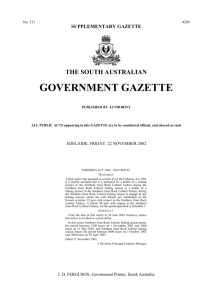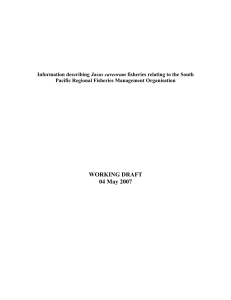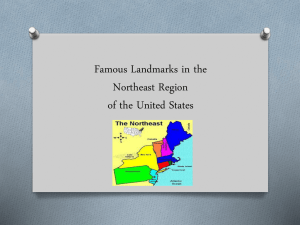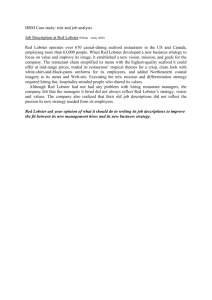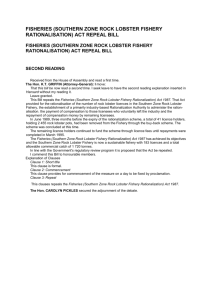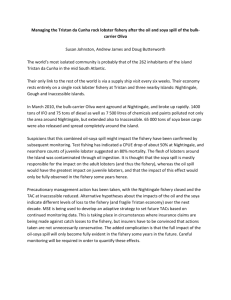AMERICAN LOBSTER Homarus americanus Sometimes known as
advertisement
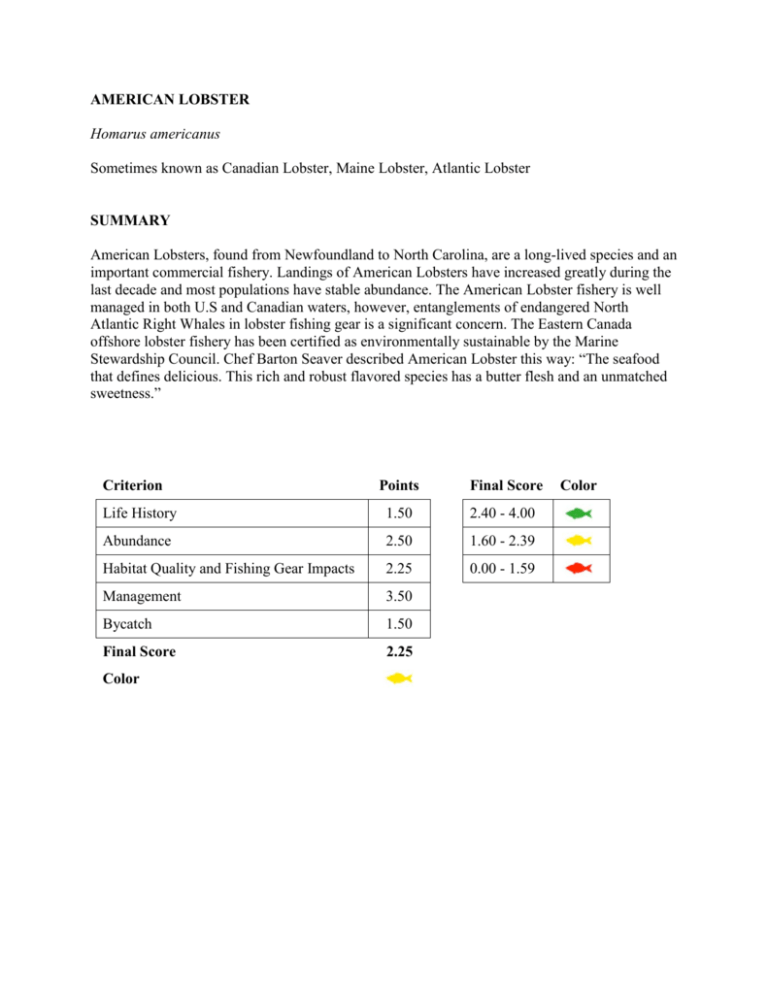
AMERICAN LOBSTER
Homarus americanus
Sometimes known as Canadian Lobster, Maine Lobster, Atlantic Lobster
SUMMARY
American Lobsters, found from Newfoundland to North Carolina, are a long-lived species and an
important commercial fishery. Landings of American Lobsters have increased greatly during the
last decade and most populations have stable abundance. The American Lobster fishery is well
managed in both U.S and Canadian waters, however, entanglements of endangered North
Atlantic Right Whales in lobster fishing gear is a significant concern. The Eastern Canada
offshore lobster fishery has been certified as environmentally sustainable by the Marine
Stewardship Council. Chef Barton Seaver described American Lobster this way: “The seafood
that defines delicious. This rich and robust flavored species has a butter flesh and an unmatched
sweetness.”
Criterion
Points
Final Score
Life History
1.50
2.40 - 4.00
Abundance
2.50
1.60 - 2.39
Habitat Quality and Fishing Gear Impacts
2.25
0.00 - 1.59
Management
3.50
Bycatch
1.50
Final Score
2.25
Color
Color
LIFE HISTORY
Core Points (only one selection allowed)
If a value for intrinsic rate of increase („r‟) is known, assign the score below based on this value.
If no r-value is available, assign the score below for the correct age at 50% maturity for females
if specified, or for the correct value of growth rate ('k'). If no estimates of r, age at 50% maturity,
or k are available, assign the score below based on maximum age.
1.00
Intrinsic rate of increase <0.05; OR age at 50% maturity >10 years; OR growth rate
<0.15; OR maximum age >30 years.
The intrinsic rate of increase and actual growth rate of American Lobsters are currently
unknown (ASMFC 2007). Canada's DFO reports that the age at maturity for American
Lobster is 5-8 years (DFO 1998b; DFO 2001), however, 10-12 years may be a more
accurate estimate (Steneck, pers. comm., 2004). Lobsters may live to 100 years old, but
estimates are difficult because as Lobsters molt, they leave behind the material that would
be used for age determination (ASMFC 2000). The largest Lobster documented by the
Department of Fisheries and Oceans Canada (DFO) was 48 lbs, or approximately 40-65
years old (DFO 2001).
2.00
Intrinsic rate of increase = 0.05-0.15; OR age at 50% maturity = 5-10 years; OR a growth
rate = 0.16–0.30; OR maximum age = 11-30 years.
3.00
Intrinsic rate of increase >0.16; OR age at 50% maturity = 1-5 years; OR growth rate
>0.30; OR maximum age <11 years.
Points of Adjustment (multiple selections allowed)
-0.25 Species has special behaviors that make it especially vulnerable to fishing pressure (e.g.,
spawning aggregations; site fidelity; segregation by sex; migratory bottlenecks; unusual
attraction to gear; etc.).
-0.25 Species has a strategy for sexual development that makes it especially vulnerable to
fishing pressure (e.g., age at 50% maturity >20 years; sequential hermaphrodites;
extremely low fecundity).
-0.25 Species has a small or restricted range (e.g., endemism; numerous evolutionarily
significant units; restricted to one coastline; e.g., American lobster; striped bass;
endemic reef fishes).
American Lobsters are found only along the continental shelf waters from Newfoundland
to North Carolina (ASMFC 2000). We consider this to be a small range.
-0.25 Species exhibits high natural population variability driven by broad-scale environmental
change (e.g. El Nino; decadal oscillations).
+0.25 Species does not have special behaviors that increase ease or population
consequences of capture OR has special behaviors that make it less vulnerable to
fishing pressure (e.g., species is widely dispersed during spawning).
Egg bearing Lobsters will avoid crowds to protect their eggs, making them less likely to
enter Lobster traps. If captured, fishers return egg bearing females to the water and most
Lobsters are able to survive.
+0.25 Species has a strategy for sexual development that makes it especially resilient to
fishing pressure (e.g., age at 50% maturity <1 year; extremely high fecundity).
Female Lobsters have one clutch and carry their eggs for 9-12 months before eggs hatch
and are released (DFO 2001). Although this strategy might appear to be a vulnerability, it
actually contributes to the resilience of the population because unlike spiny lobsters and
many crab species, American Lobster have high parental investment in their eggs. Once
the eggs hatch, the larval period is short, and the per capita survival rate of eggs is high.
+0.25 Species is distributed over a very wide range (e.g., throughout an entire hemisphere or
ocean basin; e.g., swordfish; tuna; Patagonian toothfish).
+0.25 Species does not exhibit high natural population variability driven by broad-scale
environmental change (e.g., El Nino; decadal oscillations).
The American Lobster does not exhibit high natural population variability as a result of
broad-scale environmental change. The fishery was very stable from 1946 to 1986,
indicating that there are no major interannual fluctuations.
1.50 Points for Life History
ABUNDANCE
Core Points (only one selection allowed)
Compared to natural or un-fished level, the species population is:
1.00
Low: Abundance or biomass is <75% of BMSY or similar proxy (e.g., spawning
potential ratio).
2.00
Medium: Abundance or biomass is 75-125% of BMSY or similar proxy; OR
population is approaching or recovering from an overfished condition; OR
adequate information on abundance or biomass is not available.
In the U.S., American Lobsters are fished in three regions: the Gulf of Maine, Georges
Bank, and Southern New England. Total landings have increased greatly during the last
15 years, rising from 57 million pounds in 1993 to 93 million pounds in 2006 (ASMFC
2007). In the U.S., most American Lobsters come from the Gulf of Maine.
Currently, the abundance of American Lobsters varies among the regions, being
relatively stable for Georges Bank and much of the Gulf of Maine, and decreasing in
Southern New England and some of the Gulf of Maine (ASMFC 2006).
In Canada, American Lobsters are commercially fished from over 40 lobster fishing areas
(AGR 2004). In 2004, there was a 720 tonne quota with most Lobsters caught from April
to June and in December (AGR 2004). Abundance of Lobsters varies among fishing
areas, but most are stable (DFO 2009).
Because the abundance of American Lobsters is stable in most fishing regions or areas, a
core point of 2 was awarded
3.00
High: Abundance or biomass is >125% of BMSY or similar proxy.
Points of Adjustment (multiple selections allowed)
-0.25 The population is declining over a generational time scale (as indicated by biomass
estimates or standardized CPUE).
-0.25 Age, size or sex distribution is skewed relative to the natural condition (e.g., truncated
size/age structure or anomalous sex distribution).
-0.25 Species is listed as "overfished" OR species is listed as "depleted", "endangered", or
"threatened" by recognized national or international bodies.
-0.25 Current levels of abundance are likely to jeopardize the availability of food for other
species or cause substantial change in the structure of the associated food web.
+0.25 The population is increasing over a generational time scale (as indicated by biomass
estimates or standardized CPUE).
Landings have increased in both the U.S. and Canada compared to the long-term
averages. In the U.S. landings have been increasing since the 1960s due to both
increasing fishing effort and increased lobster abundance (ASMFC 2000). In Canada,
increases have been recorded since the mid-1970s. Increases are thought to be related to
favorable environmental conditions enabling high survival of larvae (DFO 1998b; DFO
2001b). Canadian trends have now stabilized at a high level (Steneck, pers. comm.,
2004). In Southwest Nova Scotia, landings have remained high. In the Bay of Fundy,
catch rates were higher in 2000 compared to previous decades (DFO 2001b). In Maine,
where most lobsters in U.S. waters are caught, landings are at a record high. However,
populations in Rhode Island and Long Island, NY, are suffering declines in their
abundance due to disease and other sources of mortality (ASMFC 2002). During the last
few years, landings of American Lobsters have stabilized in most fishing locations, thus
no points were added
+0.25 Age, size or sex distribution is functionally normal.
The Atlantic States Fishery Management Commission reports that size composition is
severely truncated. They state that in the U.S., the majority of Lobsters landed are newly
recruited animals, meaning that they have just barely reached legal size. On Georges
Bank, 80% of landed female Lobsters are within this category. This means that the
animals are not 50% mature at this size and have not yet reproduced. The size of the
Lobsters brought in has fluctuated a bit over the years and has been increasing in recent
years (ASMFC 2000). In Canada, most Lobsters caught are first year recruits, meaning
that Lobsters are primarily caught between the minimum size and the first molt. There are
fewer older animals in the population. It is difficult to determine, however, what the
precise distribution of the catch is because the minimum size has changed many times in
the southern Gulf of St. Lawrence fishery (Comeau 2001).
Even though there are more female Lobsters in the larger size classes as a result of the
prohibiton on catching female Lobsters, some lobster scientists state that this sex ratio is
not necessarily a problem as long as there is no limitation on available sperm. Because
dominant male Lobsters can inseminate a female who can in turn save her eggs for two
years, builds in a safety mechanism for fertilization. In addition, fishery reports state that
the size distribution of the Lobster population is skewed toward the smaller Lobsters.
However, according to some lobster scientists, this pattern does not mean that the largest
Lobsters are gone. Instead, by keeping the large classes and increasing the number of
small Lobsters in the population, the same ratio can be attained. Steneck (personal
communication, 2004), argues that there has been an increase in the largest size classes
and that there has been a population explosion among young Lobsters.
+0.25 Species is close to virgin biomass.
For millennia, Lobsters were consumed by cod. Now that abundance of cod is low, there
are no real predators of Lobsters and Lobster abundance has never been so high.
Consequently, American Lobsters can be considered close to virgin biomass, or at
unfished levels, given the lack of trophic limitations of today (Steneck, pers. comm.,
2004).
+0.25 Current levels of abundance provide adequate food for other predators or are not known
to affect the structure of the associated food web.
2.50 Points for Abundance
HABITAT QUALITY AND FISHING GEAR IMPACTS
Core Points (only one selection allowed)
Select the option that most accurately describes the effect of the fishing method upon the habitat
that it affects
1.00
The fishing method causes great damage to physical and biogenic habitats (e.g., cyanide;
blasting; bottom trawling; dredging).
2.00
The fishing method does moderate damage to physical and biogenic habitats (e.g.,
bottom gillnets; traps and pots; bottom longlines).
In Canadian fisheries, all American Lobsters are caught with traps (Comeau 2001). In the
U.S., Lobsters are caught primarily with traps. Approximately 2% of landings are taken
with trawl gear (ASMFC 2000).
3.00
The fishing method does little damage to physical or biogenic habitats (e.g., hand
picking; hand raking; hook and line; pelagic long lines; mid-water trawl or gillnet; purse
seines).
Points of Adjustment (multiple selections allowed)
-0.25 Habitat for this species is so compromised from non-fishery impacts that the ability of the
habitat to support this species is substantially reduced (e.g., dams; pollution; coastal
development).
-0.25 Critical habitat areas (e.g., spawning areas) for this species are not protected by
management using time/area closures, marine reserves, etc.
-0.25 No efforts are being made to minimize damage from existing gear types OR new or
modified gear is increasing habitat damage (e.g., fitting trawls with roller rigs or
rockhopping gear; more robust gear for deep-sea fisheries).
-0.25 If gear impacts are substantial, resilience of affected habitats is very slow (e.g., deep
water corals; rocky bottoms).
+0.25 Habitat for this species remains robust and viable and is capable of supporting this
species.
In the U.S. most American Lobsters are caught in state waters, which extend from zero to
three miles from shore (ASMFC 2007). Most of the Lobster habitat in U.S and Canadian
waters remains robust.
+0.25 Critical habitat areas (e.g., spawning areas) for this species are protected by management
using time/area closures, marine reserves, etc.
+0.25 Gear innovations are being implemented over a majority of the fishing area to minimize
damage from gear types OR no innovations necessary because gear effects are minimal.
+0.25 If gear impacts are substantial, resilience of affected habitats is fast (e.g., mud or sandy
bottoms) OR gear effects are minimal.
2.25 Points for Habitat Quality and Fishing Gear Impacts
MANAGEMENT
Core Points (only one selection allowed)
Select the option that most accurately describes the current management of the fisheries of this
species.
1.00
Regulations are ineffective (e.g., illegal fishing or overfishing is occurring) OR the
fishery is unregulated (i.e., no control rules are in effect).
2.00
Management measures are in place over a major portion over the species' range but
implementation has not met conservation goals OR management measures are in place
but have not been in place long enough to determine if they are likely to achieve
conservation and sustainability goals.
3.00
Substantial management measures are in place over a large portion of the species
range and have demonstrated success in achieving conservation and sustainability
goals.
Both the U.S. and Canada manage their American Lobster fisheries, through the Atlantic
States Marine Fisheries Commission and Department of Fisheries and Oceans,
respectively.
Management measures include limited entry programs, limits on the number of traps
allowed, minimum sizes, escape vents on traps, and prohibitions on landing egg bearing
females.
In most fishing locations, the abundance of American Lobsters is healthy (ASMFC 2007,
DFO 2009) indicating good management overall.
Points of Adjustment (multiple selections allowed)
-0.25 There is inadequate scientific monitoring of stock status, catch or fishing effort.
-0.25 Management does not explicitly address fishery effects on habitat, food webs, and
ecosystems.
There are currently no management measures in place specifically to address effects of
fishery on the ecosystem (Selburg, pers. comm., 2004). However, there are no indicators
that American Lobsters are affecting the ecological community. For example, in areas
where Lobsters have died off (e.g. Long Island), there were no visible effects. This
indicates that Lobsters are not 'strong interactors' in the community (Steneck, pers.
comm., 2004). Thus, no pints are subtracted.
-0.25 This species is overfished and no recovery plan or an ineffective recovery plan is in
place.
-0.25 Management has failed to reduce excess capacity in this fishery or implements subsidies
that result in excess capacity in this fishery.
+0.25 There is adequate scientific monitoring, analysis and interpretation of stock status,
catch and fishing effort.
Catches are monitored and stock assessments are performed in both the U.S. and Canada.
Management agencies in both countries are working toward development of better
monitoring of populations (ASMFC 2002; DFO 2001).
+0.25 Management explicitly and effectively addresses fishery effects on habitat, food webs,
and ecosystems.
+0.25 This species is overfished and there is a recovery plan (including benchmarks, timetables
and methods to evaluate success) in place that is showing signs of success OR recovery
plan is not needed.
+0.25 Management has taken action to control excess capacity or reduce subsidies that
result in excess capacity OR no measures are necessary because fishery is not
overcapitalized.
Although the American Lobster fisheries are not formally classified as 'overcapitalized,'
all management areas in U.S. waters are working to limit effort in the fishery. For
example, most areas are working to reduce the number of traps in the fishery. Maine and
Canada have limits on the number of licenses allowed. Canadian managers are also
working to reduce exploitation rates (Comeau, pers. comm., 2003).
3.50 Points for Management
BYCATCH
Core Points (only one selection allowed)
Select the option that most accurately describes the current level of bycatch and the
consequences that result from fishing this species. The term, "bycatch" used in this document
excludes incidental catch of a species for which an adequate management framework exists. The
terms, "endangered, threatened, or protected," used in this document refer to species status that is
determined by national legislation such as the U.S. Endangered Species Act, the U.S. Marine
Mammal Protection Act (or another nation's equivalent), the IUCN Red List, or a credible
scientific body such as the American Fisheries Society.
1.00
Bycatch in this fishery is high (>100% of targeted landings), OR regularly includes
a "threatened, endangered or protected species."
The vast majority of American Lobsters are caught with traps, which have low bycatch of
non-targeted finfish and undersized lobster species. Bycatch is low because Lobster traps
are vented (Stockwell 2001). However, there are significant concerns about
entanglements of endangered North Atlantic right whales (Eubalaena glacialis) in
Lobster fishery gear. The population of right whales is currently estimated at only 300
animals due to centuries of hunting. Even though right whales have been protected from
hunting for decades, the right whale population declined during the 1990s. Entanglements
in fishing gear and collisions with ships are thought to be major causes of the decline.
Right whales are known to feed in areas off New England and Canada where Lobster
fisheries occur (Clapham and Pace 2001). In 2009, there were five confirmed right whale
entanglements with lobster and other fishing gear (Dean 2009). Approximately 80% of
adult right whales have scars on their body from fishing entanglement (Dean 2009).
2.00
Bycatch in this fishery is moderate (10-99% of targeted landings) AND does not
regularly include "threatened, endangered or protected species" OR level of bycatch is
unknown.
3.00
Bycatch in this fishery is low (<10% of targeted landings) and does not regularly include
"threatened, endangered or protected species."
Points of Adjustment (multiple selections allowed)
-0.25 Bycatch in this fishery is a contributing factor to the decline of "threatened, endangered,
or protected species" and no effective measures are being taken to reduce it.
-0.25 Bycatch of targeted or non-targeted species (e.g., undersize individuals) in this fishery is
high and no measures are being taken to reduce it.
-0.25 Bycatch of this species (e.g., undersize individuals) in other fisheries is high OR bycatch
of this species in other fisheries inhibits its recovery, and no measures are being taken to
reduce it.
-0.25 The continued removal of the bycatch species contributes to its decline.
+0.25 Measures taken over a major portion of the species range have been shown to
reduce bycatch of "threatened, endangered, or protected species" or bycatch rates
are no longer deemed to affect the abundance of the "protected" bycatch species
OR no measures needed because fishery is highly selective (e.g., harpoon; spear).
The Atlantic Large Whale Take Reduction Plan (ALWTRP) was implemented in 1997
(and modified in 1999, 2000, and 2002) to reduce injuries and deaths to large whales due
to accidental entanglement in fishing gear in U.S. waters. Measures and programs in
place under the ALWTRP include gear changes, a Disentanglement Network, a Sighting
Advisory System, Dynamic Area Management (DAM), and Seasonal Area Management
(NMFS 2003). Canadian Lobster fisheries are not included in the U.S. ALWTRP. NMFS
tries to coordinate with the Canadian DFO by including Canadian participants in the
development of the plan. However, there are no regulations in Canadian Lobster fisheries
that specifically protect whales from fishing gear. Unlike the U.S., Canada does not have
national legislation to protect marine mammals. Canadians have been more active in
working to protect whales from ship strikes (Lankshear and Borggaard, pers. comm.,
2003). Points were added here to account for the extensive efforts in U.S. fisheries.
+0.25 There is bycatch of targeted (e.g., undersize individuals) or non-targeted species in
this fishery and measures (e.g., gear modifications) have been implemented that
have been shown to reduce bycatch over a large portion of the species range OR no
measures are needed because fishery is highly selective (e.g., harpoon; spear).
In both U.S. and Canadian fisheries traps have escape vents to release undersized
Lobsters and other unwanted species (ASMFC 2002).
+0.25 Bycatch of this species in other fisheries is low OR bycatch of this species in other
fisheries inhibits its recovery, but effective measures are being taken to reduce it
over a large portion of the range.
No information was available to determine if bycatch of American Lobster in other
fisheries is a significant problem.
+0.25 The continued removal of the bycatch species in the targeted fishery has had or will
likely have little or no impact on populations of the bycatch species OR there are no
significant bycatch concerns because the fishery is highly selective (e.g., harpoon; spear).
1.50 Points for Bycatch
REFERENCES
Agriculture and Agri-Food Canada (AGR) (2004) Atlantic Lobster. Available at: http://atn-riae.
agr.ca/seafood/lobster-e.htm
Atlantic States Marine Fisheries Commission (ASMFC). 2002. 2002 Review of the Atlantic
States Marine Fisheries Commission Fishery Management Plan for American Lobster.
ASMFC. 2000. Stock Assessment Report No. 00-01 (Supplement) of the Atlantic States Marine
Fisheries Commission. American Lobster Stock Assessment Report for Peer Review.
Clapham, P.J. and R.M. Pace, III. April 2001. Northeast Fisheries Science Center Reference
Document 01-06. Defining Triggers for Temporary Area Closures to Protect Right Whales for
Entanglements: Issues and Options.
Comeau, M. 2001 and 2003. Personal communication. Canadian Department of Fisheries and
Oceans Canada.
Dean, C. 2009. The fall and rise of the Right Whale. http://www.nytimes.com/2009/0317/science
/17whal.html.
Department of Fisheries and Oceans Canada, Science (DFO). 2002. Southern Gulf of St.
Lawrence Lobster (Lobster Fishing Areas 23, 24, 25, 26A, and 26B). DFO Sci. Stock Report C312.
DFO. 2001. Southwest Nova Scotia Lobster. Status Stock Report C3-62 (2001).
DFO. 2001b. Bay of Fundy Lobster. Stock Status Report C3-61 (2001).
DFO. 1998b. Southern Gulf of St. Lawrence Lobster. Status Stock Report C3-12 (1998).
Frady, T. 2003. Personal Communication. National Marine Fisheries Service.
Lankshear, L. and D. Borggaard. 2003. Personal Communication. National Marine Fisheries
Service.
Lanteigne, M. 2003. Personal Communication. Department of Fisheries and Oceans Canada.
Selburg, C. 2004. Personal Communication. Atlantic States Marine Fisheries Commission.
Steneck, R.S. 2004. Personal Communication. University of Maine.
Steneck, R.S., and C.J. Wilson. 2001. Large-scale and long-term, spatial and temporal patterns in
demography and landings of the American lobster, Homarus americanus, in Maine. Marine and
Freshwater Research 52: 1303-19.
Stockwell, T. 2001. Personal Communication. Maine Department of Marine Resources.
